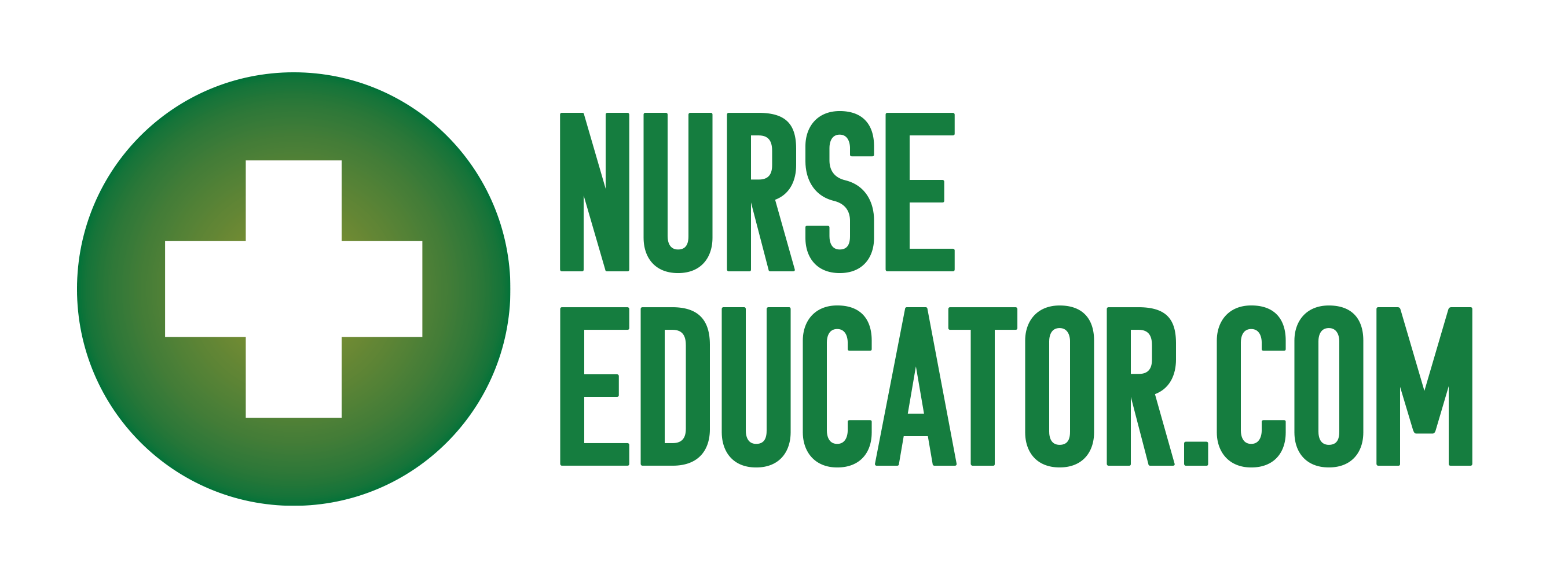Addressing the Nursing Faculty Shortage: Strategies for Recruitment and Retention of Nurse Educators

Brief Overview of the Nursing Faculty Shortage
The nursing profession is facing a growing crisis—not just in the shortage of nurses but also in the educators responsible for training the next generation of healthcare providers. Across the United States and globally, nursing schools are struggling to fill faculty positions due to factors such as:
- An aging workforce, with many faculty members nearing retirement.
- High educational requirements, requiring at least a Master's or Doctorate.
- Salary disparities, where clinical nurses often earn significantly more than faculty members.
- Heavy workloads, leading to burnout and job dissatisfaction.
As a result, many nursing programs are forced to turn away qualified applicants due to a lack of faculty, further exacerbating the ongoing nursing shortage.
The Impact of the Faculty Shortage on Nursing Education and Healthcare
| Impact Area | Effects of Faculty Shortage |
|---|---|
| Nursing Education |
|
| Healthcare Workforce |
|
| Patient Care |
|
Exploring Effective Recruitment and Retention Strategies
To address this pressing issue, nursing schools, healthcare institutions, and policymakers must implement targeted strategies to both recruit new nursing faculty and retain existing educators. This article explores solutions such as:
- Competitive salaries and benefits to attract educators.
- Flexible teaching options such as hybrid or online roles.
- Partnerships with healthcare institutions to encourage dual clinician-educator roles.
- Mentorship programs to support new faculty members.
- Work-life balance improvements to reduce burnout.
Understanding the Nursing Faculty Shortage
Current State of the Shortage
According to recent data:
- Roughly 2,000 faculty positions remain unfilled across nursing schools in the U.S.
- One-third of current faculty members are expected to retire within the next 10 years.
- More than 78,000 qualified applicants were turned away from nursing programs in 2023 due to faculty shortages.
Key Causes of the Faculty Shortage
Salary Disparities
- Nurse educators earn significantly less than clinical nurses.
- Example: A nurse practitioner (NP) can earn $120,000+, while a faculty member with a doctoral degree may earn $80,000–$90,000.
Educational Barriers
- Many academic roles require doctorate level education, limiting the pool of eligible candidates.
- Cost and time investment for further education discourage potential faculty members.
Workload and Burnout
- Faculty members often juggle teaching, research, and administrative duties.
- Limited support staff increases stress levels.
Effective Recruitment Strategies for Nursing Faculty
Competitive Compensation and Benefits
To attract more qualified nursing educators, institutions must offer:
- Salary increases to match clinical roles.
- Loan forgiveness programs for those pursuing faculty positions.
- Relocation incentives for out-of-state faculty hires.
Comparison of Salaries: Nursing Faculty vs. Clinical Roles
| Position | Average Salary (USD) |
|---|---|
| Nurse Practitioner | $120,000 – $140,000 |
| Clinical Nurse Specialist | $100,000 – $120,000 |
| Nursing Faculty (MSN) | $75,000 – $90,000 |
| Nursing Faculty (PhD/DNP) | $85,000 – $100,000 |
Creating Pathways from Clinical Practice to Academia
To encourage experienced nurses to transition into education:
- Offer bridge programs that prepare clinicians for teaching.
- Allow part-time teaching alongside clinical practice.
- Provide tuition assistance for nurses pursuing advanced degrees.
Leveraging Technology and Flexible Teaching Options
- Hybrid teaching models (online + in-person) allow faculty to work remotely.
- Virtual simulation labs reduce in-person teaching demands.
- Adjunct faculty opportunities help experienced nurses contribute without a full-time commitment.
Strengthening Partnerships with Healthcare Institutions
- Hospitals can fund “educator-clinician” dual roles.
- Health systems can offer stipends or grants for nurses pursuing educator roles.
- Joint training initiatives can support both practicing nurses and future faculty.
Retention Strategies to Sustain a Strong Nursing Faculty Workforce
Improving Work-Life Balance
- Reduce faculty workload by hiring more support staff.
- Offer flexible schedules to accommodate personal and professional responsibilities.
- Provide mental health and wellness programs to prevent burnout.
Fostering a Supportive Academic Culture
- Create mentorship programs for new faculty members.
A well-structured mentorship program is essential for supporting new nursing faculty, enhancing retention, and fostering professional development. Institutions should pair new educators with experienced mentors to provide guidance on teaching strategies, curriculum development, and career growth. Regular one-on-one meetings, structured onboarding, and peer mentorship opportunities help new faculty navigate academic responsibilities and build confidence in their roles. Additionally, offering incentives for mentors and creating both online and in-person mentorship networks can strengthen collaboration, reduce burnout, and ensure long-term success in nursing education.
- Encourage collaborative research opportunities to enhance career satisfaction.
Encouraging collaborative research opportunities can enhance career satisfaction by fostering professional growth, intellectual engagement, and interdisciplinary connections among nursing faculty. Institutions should create a supportive environment where educators can work together on research projects, publish scholarly articles, and present at conferences. Providing funding, dedicated research time, and partnerships with healthcare organizations can further motivate faculty to pursue meaningful studies that contribute to the advancement of nursing education and practice. By promoting collaboration, faculty members gain a sense of achievement, professional recognition, and long-term career fulfillment.
- Recognize outstanding faculty contributions with awards and incentives.
Recognizing outstanding faculty contributions through structured awards and incentives is essential for fostering excellence and long-term commitment in nursing education. Institutions must implement formal recognition programs that honor achievements in teaching, research, and mentorship, offering meaningful rewards such as financial bonuses, professional development grants, and career advancement opportunities. Public acknowledgment through institutional events, publications, and digital platforms reinforces a culture of appreciation and inspires continued dedication. By prioritizing faculty recognition, institutions not only enhance retention but also drive innovation and excellence in nursing education.
Career Growth and Advancement Opportunities
- Offer clear promotion pathways from instructor to professor.
- Support faculty in pursuing research and leadership roles.
- Encourage continuing education and professional development.
Leveraging Government and Policy Support
Advocacy is crucial in addressing the faculty shortage. Institutions should:
- Lobby for increased federal and state funding for nursing education.
To effectively lobby for increased federal and state funding for nursing education, institutions must take a strategic, multi-faceted approach that combines advocacy, data-driven arguments, and collaboration with key stakeholders.
Gather comprehensive data on nursing faculty shortages, student enrollment caps, and workforce demands to present compelling evidence of the need for increased funding. This includes demonstrating how a lack of faculty directly impacts the nursing workforce and, ultimately, patient care.
Engage directly with policymakers at the state and federal levels. This can be done by organizing meetings with legislators, submitting policy proposals, and participating in government hearings to advocate for increased financial support for nursing programs, faculty salaries, and student scholarships. Partnering with nursing associations such as the American Association of Colleges of Nursing (AACN) and the National League for Nursing (NLN) can amplify these efforts and provide additional legislative expertise.
Additionally, institutions should mobilize grassroots support by encouraging faculty, students, healthcare organizations, and the public to contact their representatives and advocate for funding. Hosting public awareness campaigns, utilizing media platforms, and publishing policy briefs can further reinforce the urgency of the issue.
Institutions can strengthen their lobbying efforts by building coalitions with hospitals, healthcare systems, and industry leaders who rely on a strong nursing workforce. By presenting a united front, they can more effectively push for legislation that secures long-term investments in nursing education.
- Support scholarships and grants for aspiring nurse educators.
- Advocate for legislation supporting competitive salaries for faculty.
Call to Action for Education and Healthcare Institutions
The nursing faculty shortage presents a significant challenge to the future of nursing education and healthcare. However, with proactive recruitment and retention strategies, institutions can attract and retain skilled educators. By offering competitive salaries, flexible teaching models, faculty support programs, and government-backed funding initiatives, the academic nursing workforce can be strengthened.
Nursing educator schools, healthcare institutions, and policymakers must work together to implement sustainable solutions that ensure the continued growth of the nursing profession. Investing in faculty today means securing the future of nursing education and patient care.


- Addressing the Nursing Faculty Shortage: Strategies for Recruitment and Retention of Nurse Educators - March 15, 2025
- Debunking Common Nurse Educator Myths and Misconceptions - November 5, 2024
- 6 Affordable Nurse Educator DNP Programs - March 7, 2024

